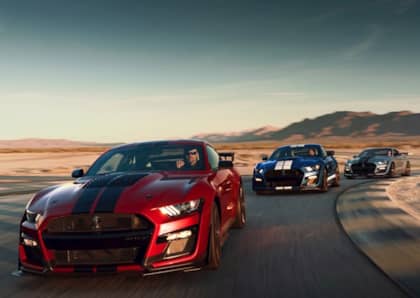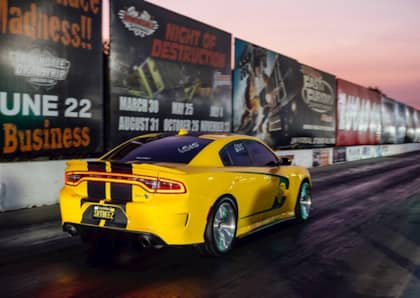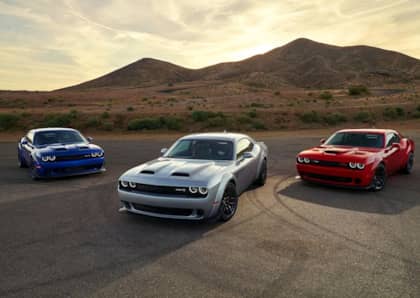The '21 BMW M4 Competition Vs. Ford Mustang Shelby GT500 & Dodge Challenger SRT Hellcat Redeye: Which Muscle Machine Hits Hardest?
The BMW M4 coupe has been redesigned for 2021, and while its new front-end styling can be generously described as 'controversial,' there's little to debate when it comes to its performance. Base versions of the car feature a 473hp 3.0L twin-turbo straight-six engine, but if you opt for the Competition package—a mere $3,000 premium over the base model's $71,800 price tag—you get an extra 30 ponies along with a sizable 73 extra lb-ft of torque (for a total of 479 lb-ft).

Photo: Benjamin Hunting
What's the catch? The BMW M4 Competition comes exclusively with an eight-speed automatic transmission, leaving the clutch pedal and six-speed manual box behind for the entry-level car. It's a trade that BMW M fans are increasingly being asked to make as the brand's Competition editions proliferate through the line-up, and it's a choice that's far from unique to the Germany luxury performance world.

Take a look at the hottest muscle cars currently available from Detroit and you'll see a similar march away from manuals. Both the Ford Mustang Shelby GT500 and the Dodge Challenger SRT Hellcat Redeye push past 700 hp while locking in an automatic as their only available gearbox.

Photo: Benjamin Hunting
Given that each of these monster coupes start at right around the $70k mark, I couldn't stop thinking about this new subset of the high performance market during my entire week behind the wheel of the M4 Competition. How do these three automatic-only speed demons stack up? Let's run the numbers.
2021 BMW M4 Competition
It's worth pointing out that the eight-speed automatic installed in the 2021 BMW M4 Competition is really, really good. The ZF unit has pulled duty in a wide range of vehicles over more than a decade now, and this torque-converter design has even begun to push dual-clutch automated manuals out of the high performance conversation thanks to its combination of lightning-quick gear changes at speed and smooth shifting when driven at a more relaxed pace. It's clear upgrade over the DCT found in past iterations of the M4, and it's far less fussy to use, too.

Photo: Benjamin Hunting
BMW's decision to go auto-only in the M4 Competition (and elsewhere in the Comp line-up) is largely a reflection of their dwindling buyer base for manual transmission cars. If you're going to charge more for a special model, you want to make sure it appeals to the largest possible demographic. There's no question, however, that the auto unit helps the car's 0-60 sprint check in at roughly 3.6 seconds in real-world testing, quicker than both the advertised figure and the base car. It's simply better at corralling the additional torque produced by the Competition's hotter engine tune and ensuring that the traction-adding driver's aides that come with the car work their magic on launch.

Photo: Benjamin Hunting
With both cars under four seconds in that measure it's hard to argue that either model is in any way 'slow.' Still, the M4 Competition dangles a further carrot in front of would-be owners: a 180 mph top speed accessible by paying an extra $2,500 for the M Driver's package. It's a 25 mph leg-stretch over the base car, which dwindles in the rearview mirror at a measly 155 mph.
2021 Ford Mustang Shelby GT500
Like the BMW M4 Competition, the Ford Mustang Shelby GT500 is intended to appeal to those seeking top-level performance in a two-door package. It goes about it a little differently, of course: in place the M car's six is a 5.2L V8 that's been supercharged to 760 hp and 625 lb-ft of torque, matched with a seven-speed dual-clutch automatic, the very same transmission type that BMW has left behind.

There are a couple of other quirks that further separate the Shelby GT500 and the M4 Competition, especially when it comes to price. If you want to go all-out in terms of track capability, Ford will indulge you in the Carbon Fiber Handling Package ($10,000, including carbon fiber wheels) or even a Carbon Fiber Track Package ($18,500, with the addition of stickier tires, a rear seat delete, and Recaro seats). It's easy to keep the sticker of these two seemingly divergent smokeshow machines relatively equal as you load up on options, which is a definite first for the Blue Oval.

How about putting them head-to-head on the asphalt? Numbers-wise, they're closer than you'd think, even with the huge power difference between the two. The Ford Mustang Shelby GT500 is 0.2 seconds quicker in a straight line, with its extra 300 lbs or so of curb weight and the difficulties finding traction for its overboosted engine preventing it from running away from its M4 Competition pursuer completely.

No doubt the Mustang is as good or better in terms of lap times, too, especially if you spare no expense at order time and go all-in on the Carbon Fiber Track Package. Both cars are limited to 180-mph, so in a battle for pole position you'll have to rely on more than just your right foot to put daylight between the BMW and the Ford.
2021 Dodge Challenger SRT Hellcat Redeye
The Dodge Challenger SRT Hellcat Redeye is the member of this trio that's the least concerned with lapping antics. Sure, the car will gladly pull road course duty, and its supercharged 6.2L V8 is one of the most solidly built, and heat-resistant members of the current muscle car crop. All that being said, this 797 hp beast is better enjoyed at the drag strip or on the boulevard, as its hefty proportions and even-heavier-than-the-Shelby mass keep it from displaying quite the same level of driver engagement once the corners begin to sharpen.

That's not to say that the Hellcat Redeye is any less fun—it's just a different vibe as compared to the tauter chassis found in the BMW and the Ford. Tearing away from tree with 707 lb-ft of torque at your command is an experience no other car in its class can deliver, and as long as you stay away from its standard all-season tires you'll roar to 60 mph in the same 3.6 seconds as the BMW M4 Competition. The Hellcat Redeye even makes use of an identical ZF transmission (although with a different configuration for its eight forward speeds), displaying just how versatile this gearbox truly is.

Keep in mind, too, that all that extra grunt enables a 203 mph top speed for the SRT Hellcat Redeye, an astonishing number that's in another league compared to the Mustang and the M4. One other thing that the Challenger can count on that its rivals can't? Family friendly fun. The rear seat in the Dodge is sized to accommodate adult human beings, which is more than can be said for the space behind the M4 Competition's ultra-stiff sport seats or the Mustang's available Recaros.











